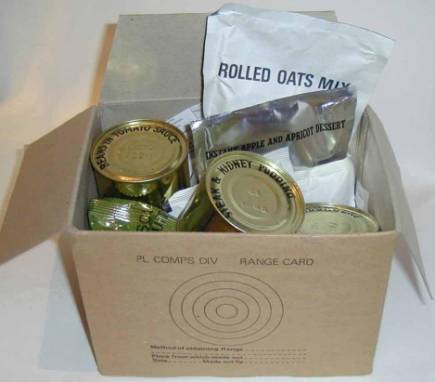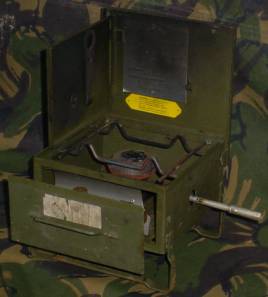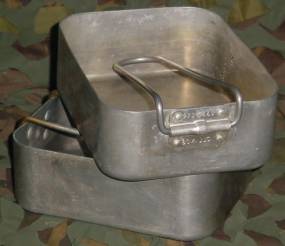RATION PACKS 1970-1991
Army Operational Rations
Under normal conditions the soldier is fed according to a standard ration scale, which is based on normal civilian
feeding habits. Items of fresh food, such as bread, frozen meat, vegetables and fruit, are provided, and all the necessary
cooking equipment is available for preparing the meals. When, however, supply becomes difficult, as during wartime
when troops are situated far from their home bases, tinned equivalents of the fresh items are brought into issue. Such
substitution may be applied to part or to the whole of the ration, and it is continued until fresh items again become
available.
While troops are congregated in one area in large units and formations, the method of feeding from a central supply depot
is possible, but it fails when units are widely dispersed in independent groups, or when the conditions for distributing
supplies have become too difficult for breaking up bulk stocks as, for instance, during landing operations.
The problem, is solved by the issue of composite ration packs, which contains a definite number of complete, balanced
rations. This allows the complicated and lengthy process of issuing multiple quantities of all the items on the ration
scale, to be simplified by handing out the appropriate number of composite ration cases from a single stack. These
operational rations are the only food the soldier can expect to get as long as the same conditions last, so that they must
be adequate to keep him healthy and provide the necessary energy for his activities. At one time the soldier was content, or
had to be content, with a tin of bully beef and a packet of biscuits for the day’s ration, but the present-day army demands
a full and varied diet.
The modern practice, therefore, is to design rations of such a nature that, in any circumstances, however difficult the
problem of supply, the soldier receives food as similar as possible in character and quality to that which he normally
receives at his base camp. The importance of food to his morale is recognized, and efforts are made to provide him with a
full and varied diet.
The conditions which operational rations must meet are:
(1) The ration should be nutritionally adequate, attractive, and sufficiently varied in composition to ensure general
acceptability when consumed over a fair period of time.
(2) The items in the ration should be such that appetizing meals can be prepared by the soldiers themselves, who are
probably unskilled in the art of cooking, without the aid of normal cooking equipment.
(3) The ration should be in a compact and convenient form, suitable for rapid distribution and use during special operations
such as assault landings, or on long-range patrols.
(4) The packaging should be adequate to withstand very rough handling without damage to the contents, and the weight of
packing should be reduced to a minimum consistent with efficiency.
(5) The ration packs must withstand long storage in any climatic conditions without chemical or microbial deterioration.
During the last war, many different operational ration packs were produced for use in varying circumstances. They included
various composite rations, special Pacific packs, jungle ration, AFV (armoured fighting vehicle) ration and mountain (Arctic)
ration. As a result of experience and of the administrative difficulties of getting the right ration to the right place for
consumption, it was decided that standardization was essential. The need for standardization has governed the design of the
present-day operational ration packs which are now few in number and capable of almost universal application.
The types are as follows:
Ration, Composite General Service, 10 Man
Ration, Composite General Service, 4 Man
Ration, Composite General Service, 24 Hour
All the rations provide food for three meals, breakfast, main meal and tea or snack meal.
Ration, Composite GS, 10 Man
The ten-men composite ration is the main pack used for operational purposes. It contains food for ten men for 1 day, or for
five men for 2 days. It is formulated in four different menus in order to prevent monotony. All items are contained in
hermetically sealed cans, mostly of size 1, containing approximately 16 ounces of produce.
Thirty cans, size 1 (or pairs of the smaller size 2) are contained in a weatherproof cardboard case divided up by interlocking
partitions, and fitted with an external sleeve. The weight of the case is 43lb/19.5kg.
Almost all the food items are already cooked, and only require heating in water before consumption, as it rarely occurs that the soldier cannot manage to ‘brew-up’, he can usually contrive to heat his rations. In addition to the food items, the packs contain tea, sugar, milk, sweets and such sundries as matches, soap, a can-opener and water-sterilizing outfits.
The average calorific value of the rations is 4100Cal. per man daily.
Ration, Composite GS, 10 Man (1983)

Ration, Composite GS, 4 Man
The Four-man composite ration provides sufficient food for four men for 1 day, and is specially designed for use by tank crews. The size and shape of the case are dictated by the restricted space, which can be allotted in a tank for carrying food. In composition and general make-up the four-man composite ration is similar to that for ten men. The weight of the pack is 19.2lb/8.9kg, and the average calorific value is 4100Cal. per man daily.
Ration, Composite GS, 4 Man (1989)

Part of Ration, Composite GS, 4 Man (1978)

Ration, Composite GS, 24 Hour
The twenty-four hour ration G.S. contains food for one man for 1 day; it is intended for use by soldiers in special
circumstances where each man has to be independent and carry his own food. The ration weighs 3.4lb/1.54kg, and has a
calorific value of 3600 Cal.
It is issued in four different menus, and each ration is divided into three separate meal
packets for breakfast, main meal and snack. Each packet contains sufficient biscuits for the particular meal. In addition,
there is a pouch containing a tube of condensed milk, salt, matches, a can-opener and other sundries.
A meat dish is provided for breakfast, and meat with vegetables followed by a pudding for the main meal. The snack packet
contains biscuits, and various items of confectionery which are intended to be consumed periodically throughout the day.
All the items of the pack are contained in small cans or in foil-laminated pouches as a protection from water vapour. The
twenty-four-hour ration, G.S. is of somewhat elaborate construction, and is intended for consumption for a few days only at
any one time.
Ration, Composite GS, 24 Hour, Menu B (1981)

MENU "B" Componants (1981)
BREAKFAST:
Porridge (rolled oats), Bacon Burger, Biscuits Brown & Chocolate Drink
SNACK:
Biscuits Brown, Beef Spread, Milk Chocolate bar, Chocolate Covered Caramel bar, Boiled sweets & Dextrose Tablets (Orange)
MAIN MENU:
Biscuits Fruit, Instant Soup, Steak & Kidney Pudding, Spaghetti in Tomato Sauce & Apple and Apricot Flakes
DRINKS:
Instant Skimmed Milk, Sugar, Tea, Coffee, Beef Stock Drink and Orange or Lemon Powder.
SUNDRIES:
Chewing Gum, Toilet Paper, Salt, Book matches, Waterproof matches, Can Opener, Water Purification tablets and
Menu Sheet.
In 1997 the British Armed Forces began to replace the General Service Ration, with the new General Purpose Ration, and
was completed by 1999. In the new "Ration GP", the tins were replaced with foil pouches, and more thought was given to the
calorific value. The "Ration, GP 24 Hour", provides an average of 3800-4200 Kcal per ration. The ration is 10% protein, no
more than 35% fat, and 55% carbohydrate. Recomended continuous consumption up to 15 days, ideally no longer than 30 days
due to nutritional qualities.
COOKERS
Hexamine Cooker
Issued for use with the 24 hour Ration Pack GS, the Hexamine Folding Cooker, has been used by the British Armed Forces for
decades. Standard issue for each soldier is one cooker containing fuel plus 2 fuel refills, for the preparation of all hot
foods and drinks for up to a period of 72 hours.
The hexamine fuel tablet is a form of solid fuel, 8 tablets to a packet. The tablets burn smokelessly, have a high energy
density, do not liquify while burning and leave no ashes. Invented in Murrhardt, Germany, in 1932, the main component is
hexamine.
Hexamine Cooker

Unfortunately, there are several draw backs with the "Hexi" cooker:
(1) When burned, Hexamine fuel tablets produce toxic fumes so the cooker can only be used in well ventilated areas.
(2) The tablets are very difficult to light in windy areas and will not light when wet.
(3) Tablets are not a particularly powerful stove fuel.
For these reasons many soldiers opted to purchase their own stoves, usually petrol stoves, as petrol could be obtained
easily from vehicles. The "Coleman Multifuel" rapidly bacame a favorite within the British Army.
Coleman Multifuel Cooker

Cooker, Petrol No2
First introduced during WW2 the "Cooker, Petrol No2" is a single burner cooker in a folding case, which is operated by
pressurizing the petrol in the small tank at the front, similar to the "primus" type cooker. It has its own windshield
as part of the case. A funnel for filling the fuel tank is supplied, together with basic maintenance tools.
This cooker was mainly issued to crews of armoured fighting vehicles, often seen strapped to the wings of Ferret Scout Cars
as they were part of the CSE (Complete Schedule of Equipment) issued to each vehicle.
The cooker was issued with a stainless steel dixie, and a lid which doubled as a frying pan. The cooker and pan are held
together with a leather strap.
Cooker, Petrol No2

The No2 Cooker remained in service until the mid 1980's, when they became obsolete, as the British Army changing over
to diesel under the single fuel policy.
These cookers were very thirsty, but very efficient, although they needed the leather seals in the pump changing frequently
to prevent petrol leaking from the pressure pump and igniting.
Cooker, Petrol No3
The No3 cooker was a two burner unit, of similar design to the No2 cooker. It differs in design by having no built in windshield as the lid was hinged on the left side and doubled as a work surface.
Cooker, Petrol No3

COOKING VESSELS
Mess Tins
Mess tins have maintained the same basic design since the mid 1930's. Mess tins are generally rectangular with rounded off edges - the rounded edges are easier to clean inside than a sharp corner. Most mess tins are supplied as a set, with one slightly larger than the other, allowing them to nestle together for easy packing. This arrangement is also useful when using the tins for boiling, as the smaller tin can be used to hold the liquid, with the larger tin placed on top to act as a lid. In order to save weight, some designs stick with a single mess tin with a lid, with the lid often having a secondary role as a frying pan.
MESS TINS (1980 issue)
